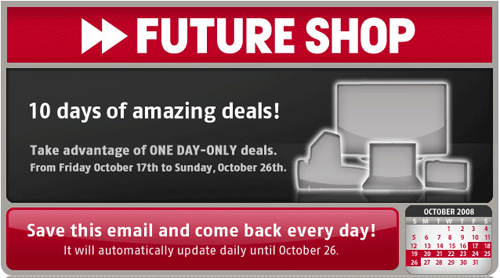Last week Future Shop, one of Canada’s biggest electronics retailers, launched a large in-house email promotion and made just about the biggest blunder you could make. Despite the fact that Future Shop made a huge rookie mistake (one of the things we coach all our email marketing clients about), I must give them kudos on a very interesting concept.
The promotion was “Future Shop 10 Days of Amazing Deals”. The idea is that the customer (in this case me) is supposed to check the same email every day and it will automatically update to show the new deals of the day. I’ll be the first to admit this does sound cool and is an interesting promotional idea. From a technical standpoint it’s actually pretty basic since they just change the image on their server that is being downloaded, but to the average end-user it’s entirely ‘different’ and ‘neat’. I suspect the marketing staff at Future Shop are relying on people flagging the message in their inbox and coming back to it. I sort of question whether that is a good strategy, but that is a question for another day.
The big blunder, that in my opinion ruined an otherwise cool idea, was the fact that when the email first landed in my inbox on “Deal Day 1”, none of the links worked. No matter what link I clicked on in the email, it only led me to a ‘page not found’ error. How on earth do you launch a campaign like this with that kind of problem? I mean, this not only looks so bad to each and every recipient (and I’ve got to imagine that’s a ton!), but it must kill their conversion ratio.
I can only imagine the look on the marketing manager’s face when he got the slick new promotional email in his inbox and found out it didn’t actually connect to the Future Shop website.
[I should mention that I had several people check the links from various locations to make sure it wasn’t just me that got unlucky with broken links.]
Like we always tell our customers, if the goal of your email is to drive traffic to your website, then a good rule of thumb is to make sure the link you’re putting in front of people actually works.

For every “deal day” since day 1, Future Shop did get things sorted out and the links have been working. But, the fact that on day 1 the link reading “If you are having problems viewing this email, please try the web edition” didn’t work…well, that’s a big time blunder.